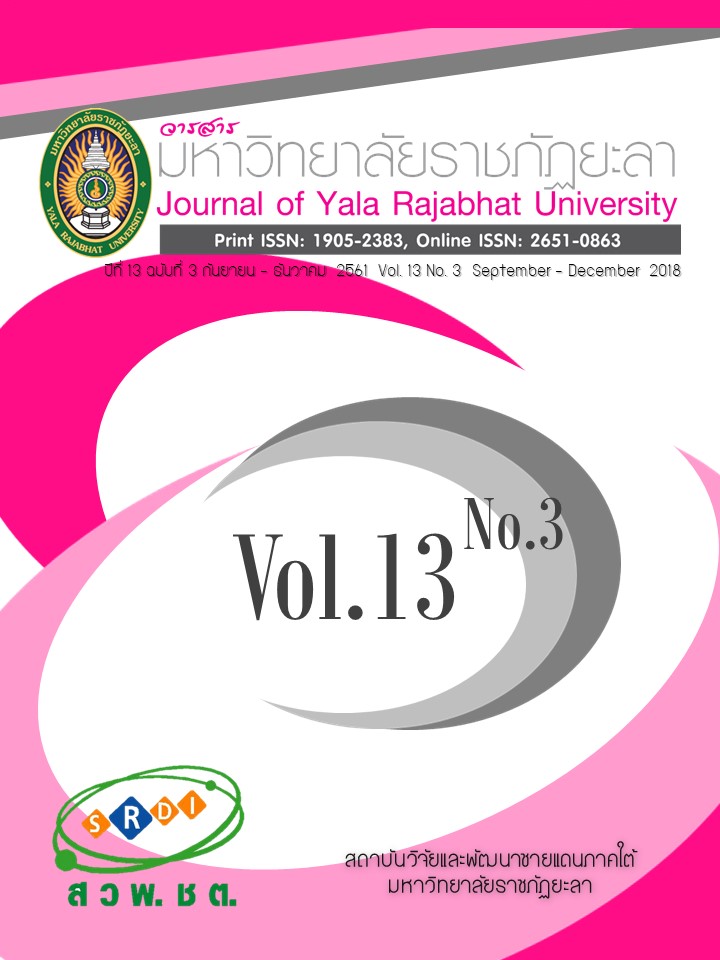การพัฒนารูปแบบการเรียนรู้ร่วมกันบนเว็บที่มีระบบพี่เลี้ยงสนับสนุนเพื่อส่งเสริมการคิด อย่างมีวิจารณญาณในระดับอุดมศึกษา
Main Article Content
บทคัดย่อ
การวิจัยนี้มีวัตถุประสงค์คือ 1)เพื่อพัฒนารูปแบบการเรียนรู้ร่วมกันบนเว็บที่มีระบบพี่เลี้ยงสนับสนุนเพื่อส่งเสริมการคิดอย่างมีวิจารณญาณในระดับอุดมศึกษา 2) เพื่อทดลองใช้รูปแบบการเรียนรู้ร่วมกันบนเว็บที่มีระบบพี่เลี้ยงสนับสนุนเพื่อส่งเสริมการคิดอย่างมีวิจารณญาณในระดับอุดมศึกษา กลุ่มตัวอย่าง ได้แก่ นักศึกษาสาขาวิชาเทคโนโลยีสารสนเทศ มหาวิทยาลัยราชภัฏบุรีรัมย์ ที่ลงทะเบียนเรียนรายวิชา 4131301 ในภาคเรียนที่ 1 ปีการศึกษา 2558 จำนวน 67 คน เครื่องมือที่ใช้ในการวิจัยประกอบด้วย เครื่องมือในการทดลองใช้รูปแบบและเครื่องมือในการเก็บรวบรวมข้อมูล ซึ่งผลการวิจัยพบว่า รูปแบบการเรียนรู้ที่พัฒนาขึ้นประกอบด้วย 4 องค์ประกอบ คือ 1) หลักการ 2) วัตถุประสงค์ 3) กระบวนการเรียนรู้มี 5 ขั้นตอน ได้แก่ ขั้นสร้างกลุ่มสัมพันธภาพ ขั้นทำความกระจ่างในปัญหา ขั้นร่วมสะท้อนความคิด ขั้นสรุปพร้อมชี้แนะ และขั้นยกย่องให้รางวัล 4) การวัดและประเมินผล ผลการทดลองใช้รูปแบบ พบว่าประสิทธิภาพของบทเรียนคอมพิวเตอร์ตามรูปแบบ มีค่าเท่ากับ 1.03 การคิดอย่างมีวิจารณญาณและผลสัมฤทธิ์ทางการเรียนของผู้เรียนที่เรียนด้วยบทเรียนคอมพิวเตอร์ตามรูปแบบสูงกว่าผู้เรียนที่เรียนด้วยวิธีแบบปกติ อย่างมีนัยสำคัญทางสถิติที่ระดับ .05 การคิดอย่างมีวิจารณญาณกับผลสัมฤทธิ์ทางการเรียนของผู้เรียนด้วยบทเรียนคอมพิวเตอร์ตามรูปแบบ มีความสัมพันธ์เชิงบวกในระดับปานกลาง (r=.688) อย่างมีนัยสำคัญทางสถิติที่ระดับ .01 และผู้เรียนมีความพึงพอใจต่อรูปแบบการเรียนรู้อยู่ในระดับมาก
Article Details
บทความ ข้อมูล เนื้อหา รูปภาพ ฯลฯ ที่ได้รับการเผยแพร่ในวารสารมหาวิทยาลัยราชภัฏยะลานี้ ถือเป็นลิขสิทธิ์ของวารสารมหาวิทยาลัยราชภัฏยะลา หากบุคคลหรือหน่วยงานใดต้องการนำทั้งหมดหรือส่วนหนึ่งส่วนใดไปเผยแพร่ต่อหรือกระทำการใดๆ จะต้องได้รับอนุญาตเป็นลายลักษณ์อักษรจากวารสารมหาวิทยาลัยราชภัฏยะลาก่อนเท่านั้น
References
2. Ardwichai, P. & Stabhornwong, P. (2011). Comparisons of Learning Achievement and Critical Thinking of Matthayomsuksa 1 Students Using Yonisomanasikara Teaching Activities and Using Teacher’s Handbook Activities. Journal of Educatioin, 22(1), 121-134. (in Thai)
3. Bierema, L. & Merriam, S. B. (2002). E-mentoring: using computer medicated communication to enhance the mentoring process. Innovative Higher Education, 26(3), 211-227.
4. Bloom, B. S. (1976). Human Characteristics and School Learning. New York: McGram-Hill Book.
5. Chernobilsky, E., Nagarajan, A. & Hmelo-Silver, C. E. (2005). Problem-based learning online: multiple perspectives on collaborative knowledge construction [Online]. Retrieved October 12, 2013, from:https://pdfs.semanticscholar.org/cd86/aa2fe6606b9f62a6e8a8ccfdbfd76c507696.pdf.
6. Chizmar, J. F. & Walber, M. S. (1999). Web-Base learning Environment Guided by Principle of Good teaching Practice. Journal of Economic Education, Summer 30(3), 248-259.
7. Cooper, James, L., Pamela, R. & Molly, M. (1994). Cooperative Learning in the Classroom in Changing College Classroom. Diane Halpern and Associates (eds). San Francisco: Jossey-Bass.
8. Khantapthai, T. (2011). A Development of a Blended Learning Model for Learning and Information Technology for Life Course of Undergraduate Students at Rajabhat University. Doctor’s Thesis. Mahasarakham University. (in thai).
9. Office of National Education Commission. (2002). National Education Act of B.E. 2542 and Amendments (Second National Education Act) of B.E. 2545. The Prime Minister’s Office. (in Thai)
10. Panich, V. (2011). Ways for Learning Creation for Students in the 21st Century. Bangkok: Sodsri-Saritwong Foundation. (in thai).
11. Rattanachuwong, S. (2008). Effects of Different Structures of Cooperative Learning on Webboard Discussion Upon Critical Thinking of Eleventh Grade Students with Different Types of Personality. Doctor’Thesis. Chulalongkorn University. (in Thai)
12. Simmatun, P. (2009). A Development of Web-based Collaborative Instructional Model base on Constructivist Theory for Undergraduate Students. Doctor’s Thesis. King Mongkut’s University of Technology North Bangkok. (in Thai)
13. Stewart, S. & Wootton, R. (2005). Design Features of an e-Mentoring System for the Health Professions: Choosing to Learn in Partnership. Telemed Telecare, 1(11), 90-92.
14. Terrion, J. & Leonard, D. (2007). A taxonomy of the characteristics of student peer mentors in higher education : findings from a literature review. Mentoring & Tutoring, 15(2), 149-164.
15. Tongroach, C. (2008). Changing New Educational Paradigms in Professional Teachers: Concepts, Tools, and Development. (2nd ed). Bangkok: Chulalongkorn University Printing House. (in Thai)
16. Worapun, W., Nuangchalerm,P. & Marasri, A. (2016). Self-directed Learning Model in Physics for High School Students. Journal of Yala Rajabhat University, 11(2), 31-35. (in Thai)

